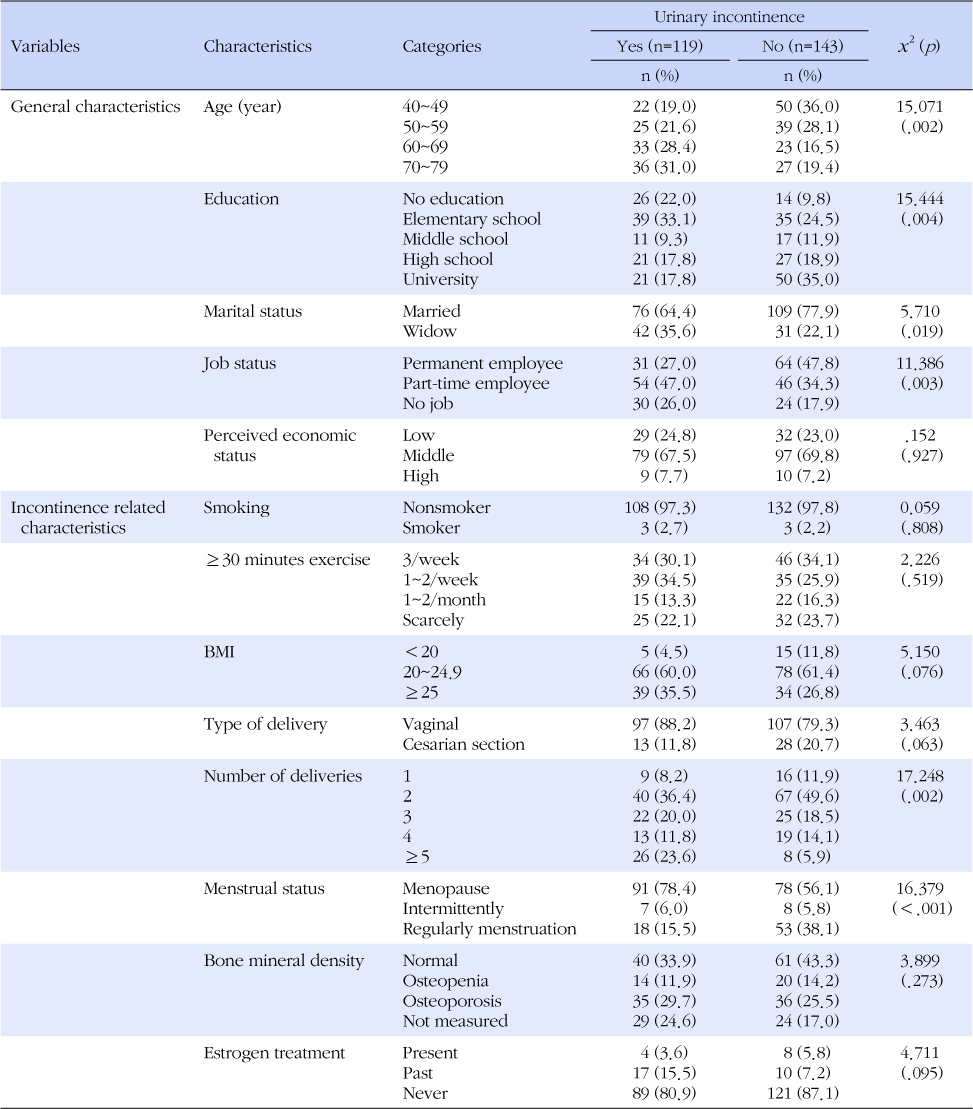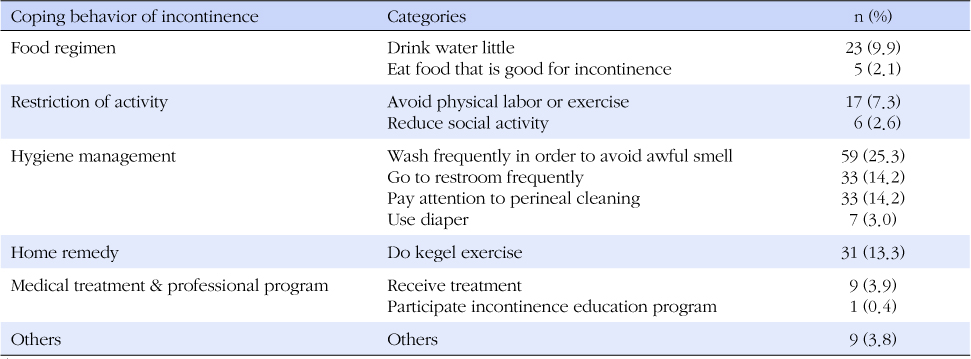Articles
- Page Path
- HOME > J Korean Acad Community Health Nurs > Volume 24(3); 2013 > Article
-
Original Article
- A Study on Urinary Incontinence Related Health Problems in Women above Middle Age in Rural Areas and Their Coping with the Problems
- Chunmi Kim, Hung Sa Lee, Eun Man Kim
-
Journal of Korean Academy of Community Health Nursing 2013;24(3):368-376.
DOI: https://doi.org/10.12799/jkachn.2013.24.3.368
Published online: September 30, 2013
1Department of Nursing, Sunmoon University, Asan, Korea.
2Department of Nursing, Daegu Haany University, Daegu, Korea.
• Received: August 13, 2013 • Accepted: September 25, 2013
© 2013 Korean Academy of Community Health Nursing
This is an Open Access article distributed under the terms of the Creative Commons Attribution Non-Commercial License (http://creativecommons.org/licenses/by-nc/3.0/) which permits unrestricted non-commercial use, distribution, and reproduction in any medium, provided the original work is properly cited.
- 768 Views
- 5 Download
- 8 Crossref
Abstract
-
Purpose
- The purpose of this study was to identify the current urinary incontinence states in women above middle age dwelling in rural areas and their coping with the problems.
-
Methods
- The participants were 261 women above middle age. Data were collected from February to May, 2012 using a structured questionnaire. The data were analyzed with the SPSS/WIN 20 program.
-
Results
- The frequency of urinary incontinence in women above middle age was 45.4%. There were significant differences in urinary incontinence due to age, education, job status, frequency of delivery, and menstrual status. And, there were significant relations among urinary symptoms, difficulty of ADL, incontinence stress and depression. Frequently used coping-methods with urinary incontinence were washing frequently in order to avoid awful smell, paying attention to perineal cleaning, and going to restroom frequently.
-
Conclusion
- Community nurses who are in charge of primary health care ought to assess urinary incontinence and develop a urinary incontinence program that includes psychological and social factors.
Table 2Differences in Urinary Incontinence according to General & Incontinence related Characteristics


- 1. Butler RN, Maby JI, Montella JM, Young GP. Urinary incontinence: Primary care therapies for the older woman. Geriatrics. 1999;54(11):31–34.
- 2. Chae MJ, So HS, Lee JS, Lee SY, Lee JH, Lim JI. Urinary incontinence and quality of life among middle- aged women in community. Chonnam J Nurs Sci. 2009;14(1):81–95.
- 3. Cho GY, Park JS. A study on the characteristics of urinary incontinence, related problems and management in elderly women in nursing homes. J Korean Gerontol Nurs. 2009;11(2):162–172.
- 4. Coyne KS, Kvasz M, Ireland AM, Milson I, Kopp ZS, Chapple CR. Urinary incontinence and its relationship to mental health and health-related quality of life in men and women in Sweden, the United Kingdom, and United States. Eur Urol. 2012;61(1):88–95. PubMed
- 5. Diokno AC, Estanol MV, Mallet V. Epidemiology of lower urinary tract dysfunction. Clin Obstet Gynecol. 2004;47(1):36–43. ArticlePubMed
- 6. Dugan E, Roberts CP, Cohen SJ, Preisser JS, Davis CC, Bland DR, et al. Why older community-dwelling adults do not discuss urinary incontinence with their primary care physicians. J Am Geriatr Soc. 2001;49(4):462–465. ArticlePubMedPDF
- 7. Fultz NH, Herzog AR. Self-reported social and emotional impact of urinary incontinence. J Am Geriatr Soc. 2001;49(7):892–899. ArticlePubMed
- 8. Gasquet I, Tcherny-Lessenot S, Gaudebout P, Goux BB, Klein P. Influence of the severity of stress incontinence on quality of life, health care seeking and treatment: A national cross sectional study. Eur Urol. 2006;50(4):818–825. PubMed
- 9. Hannestad YS, Rertveit S, Dalveit AJ, Hunskaar S. Are smoking and other lifestyle factors associated with female urinary incontinence? The Norwegian EPINCONT study. BJOG. 2003;110(3):247–254. ArticlePubMed
- 10. Kee BS. A preliminary study for the standardization of geriatric depression scale short form-Korean version. J Korean Neuropsychiatr Assoc. 1996;35(2):298–307.
- 11. Kim DS, Lim HS, Kim DH. A study on the health promotion behaviors in rural areas. J Agric Med Community Health. 2000;25(2):327–341.
- 12. Kim JI. The evaluation of 10 week urinary tract function promotion program for the elderly women in the community. Korean J Women Health Nurs. 2003;9(4):439–448. ArticlePDF
- 13. Kim KH. Study on correlation between urinary incontinence & lower urinary tract symptom and daily life of middle- aged & elderly women in urban city. Seoul: Ewha Womans University; 2002. Unpublished master's thesis.
- 14. Lee JS. A study on daily life inconvenience and quality of life related to urinary incontience in the elderly women using the welfare center. Gwangju: Chonnam National University; 2008. Unpublished master's thesis.
- 15. Lee KS, Sung HH, Na S, Choo MS. Prevalence of urinary incontinence in Korean women: Results of a national health interview survey. World J Urol. 2008;26(2):179–185. ArticlePubMedPDF
- 16. Lionis C, Vlachonikolis L, Bathianaki M, Daskalopoulos G, Anifantaki S, Cranidis A. Urinary incontinence, the hidden health problem of Cretan women: Report from a primary care survey in Greece. Women Health. 2000;31(4):59–66. ArticlePubMed
- 17. Oh HS, Kim MK. Factors affecting the severity of urinary incontinence and the quality of life of Women with urinary incontinence. J Korean Acad Nurs. 2005;35(3):469–477. ArticlePubMedPDF
- 18. Oh SJ, Hong SK, Son HC, Paick JE, Ku JH. Quality of life and disease severity in Korean women with stress urinary incontinence. Urology. 2005;66(1):69–73. ArticlePubMed
- 19. Oh SJ, Park HG, Paick SH, Park WH, Choo MS. Translation and linguistic validation of Korean version of the Bristol female lower urinary tract symptom instrument. J Korean Continence Soc. 2004;8(2):89–113. ArticlePDF
- 20. Palmer MH, Fitzgerald S. Urinary incontinence in working women: A comparison study. J Womens Health (Larchmt). 2002;11(10):879–888. ArticlePubMed
- 21. Parazzini F, Chiaffarino F, Lavezzari M, Giambanco V. Risk factors for stress, urge or mixed urinary incontinence in Italy. BJOG. 2003;110(10):927–933. ArticlePubMed
- 22. Park OH, Kwon IS, Kang YS. A study on urinary incontinence of elderly women in a community. J Korean Acad Womens Health Nurs. 2001;7(4):536–546. ArticlePDF
- 23. Rortveit G, Hannestad YS, Dalveit AJ, Hunskaar S. Age-and type-dependent effects of parity on urinary incontinence: The Norwegian EPINCONT study. Obstet Gynecol. 2001;98(6):1004–1010. ArticlePubMed
- 24. Sheikh JI, Yesavage JA. Geriatric depression scale (GDS): Recent evidence and development of a short version. Clin Gerontol. 1986;5(1-2):165–172.
- 25. Shin KR, Kang YH, Oak JW. The relationship of quality of sleep, depression, late-life function and disability in community-dwelling older women with urinary incontinence. J Korean Acad Nurs. 2008;38(4):573–581. ArticlePubMed
- 26. Sims J, Browning C, Lindquist BL, Kendig H. Urinary incontinence in a community sample of older adults: prevalence and impact on quality of life. Disabil Rehabil. 2011;33(15-16):1389–1398. ArticlePubMed
- 27. Song YS, Son YJ, Hong SK, Song JE, Cho HK. Anxiety, depression and quality of life of married women with urinary incontinence living in the community. J Korean Acad Fundam Nurs. 2007;14(4):483–492.
- 28. Wilson L, Brown JS, Shin GP, Luc KO, Subak LL. Annual direct cost of urinary incontinence. Obstet Gynecol. 2001;98(3):398–406. ArticlePubMed
- 29. Yoon HS, Kwon IS, Bae NK, Cho YC. Prevalence of urinary incontinence and its related factors among the rural residing elderlies. J Agric Med Community Health. 2009;34(1):76–86. Article
- 30. Yu LC. Incontinence stress index: measuring psychological impact. J Gerontol Nurs. 1987;13(7):18–25. ArticlePubMed
Figure & Data
References
Citations
Citations to this article as recorded by 

- Experience of Urinary Incontinence in Elderly Women in Urban Areas
Min Ryu, Haeyun Shin, Miseon Bang, Suhye Kwon
Journal of Korean Gerontological Nursing.2021; 23(3): 213. CrossRef - Long-Term Effects of a Self-management Program for Older Women With Urinary Incontinence in Rural Korea
Aeyoung So, Jennie C. De Gagne, Sunah Park
Journal of Wound, Ostomy & Continence Nursing.2019; 46(1): 55. CrossRef - Effects of Leg Strength Exercise on Muscle Strength, Flexibility and Symptoms of Urinary Incontinence of Elderly Women
Nam Young Yang, Yong Kwon Yoo, Min Sun Song
Korean Journal of Adult Nursing.2018; 30(4): 417. CrossRef - Urinary incontinence in women in relation to occupational status
Yoonjung Kim, Yeunhee Kwak
Women & Health.2017; 57(1): 1. CrossRef - Self-management Experiences of Older Korean Women With Urinary Incontinence
Sunah Park, SoonGyo Yeoum, Yoonjung Kim, Hye Jin Kwon
Journal of Wound, Ostomy & Continence Nursing.2017; 44(6): 572. CrossRef - The Effect of a Workshop on a Urinary Incontinence Self-Management Teaching Program for Community Health Nurses
Aeyoung So, Jennie C. De Gagne, Sunah Park, Young-Oak Kim
Journal of Korean Academy of Community Health Nursing.2015; 26(3): 260. CrossRef - A Urinary Incontinence Continuing Education Online Course for Community Health Nurses in South Korea
Jennie C. De Gagne, Sunah Park, Aeyoung So, Bei Wu, Mary H. Palmer, Eleanor S. McConnell
The Journal of Continuing Education in Nursing.2015; 46(4): 171. CrossRef - The Development of Neuromuscular Electrical Stimulation Medical Devices for The Treatment of Non-implantable Urinary Incontinence
Jae-Yong Lee, Chang-Doo Lee, Ki-Jin Kwon
The Transactions of the Korean Institute of Electrical Engineers P.2015; 64(3): 175. CrossRef

 KACHN
KACHN




 PubReader
PubReader Cite
Cite

